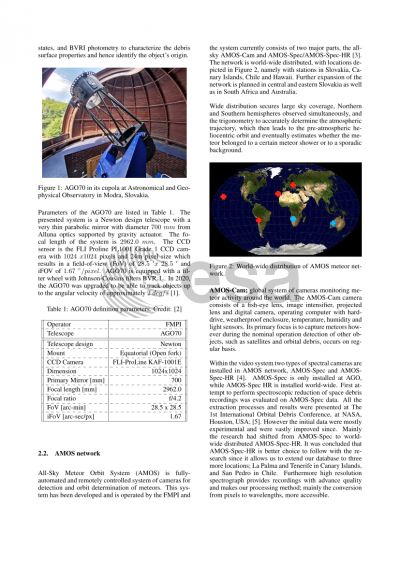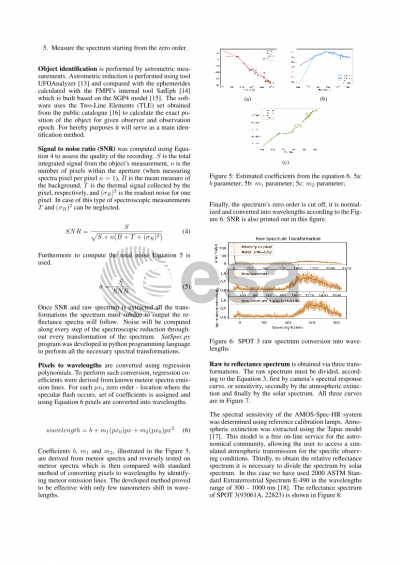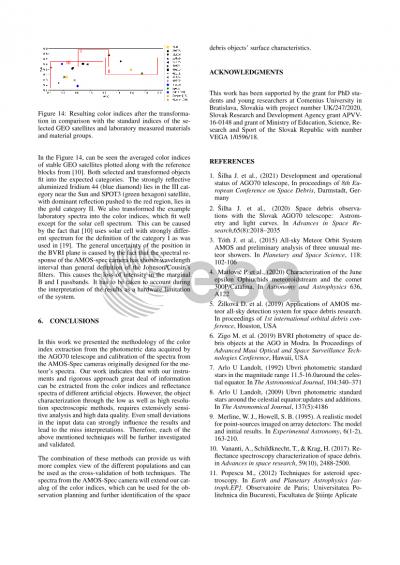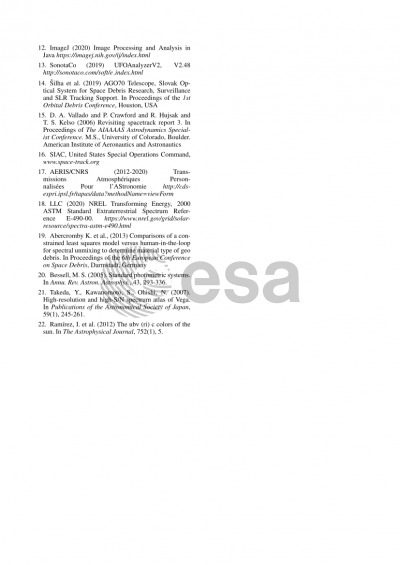Document details
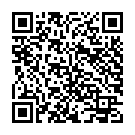
Abstract
Reflectance spectroscopy and BVRI photometry are two widely used procedures in many different fields of astronomy. Thanks to these observation techniques we categorize objects to the groups according to similarities in surface properties and characteristics, reveal some specific spectral features related to certain materials in comparison to laboratory samples or find evidence of material “reddening” caused by the space-weathering or aging effects.
The spectral data used in our work were obtained by the All-Sky Meteor Orbit System (AMOS) developed and operated by the Faculty of Mathematics, Physics and Informatics of the Comenius University in Bratislava, Slovakia (FMPI CU). AMOS system consists of the AMOS-Spec camera, which is a video system connected to AMOS-Cam for the systematic spectroscopic observations and detection of meteor spectra. Besides meteors, these cameras capture bright specular flashes of artificial objects on the geocentric orbits. If these flashes are bright enough the AMOS-Spec camera records the first order of the spectrum as well. Once the raw spectra are processed and calibrated, hereby presented pipeline corrects atmospheric extinction and sensitivity of optical system, divides the spectra by the Solar spectra and obtains the reflectance spectrum of our target. The spectrum represents the target’s ability to reflect specific wavelengths of incoming light and is specified by the characteristics of the surface material.
Our department has also BVRI photometric program, which is simultaneously running on the 70-centimeter Newtonian telescope (AGO70) installed at FMPI’s Astronomical and Geophysical observatory in Modra (AGO). AGO70’s main field of study is dedicated to space debris astrometric and photometric observations. The BVRI photometry uses the advantages of Johnson/Cousins photometric filters to obtain the ultra-low-resolution spectra named color indices. This program focuses on acquisition of the averaged and rotational phase dependence of the color indices from the diffuse reflection. Using the well-known spectral transmission of the photometric filters, we express the measured spectra in terms of color indices. Thanks to this conversion we compare the properties of the specular and diffuse reflections of similar types of objects, incorporate the target according to its spectra to the material groups in color index diagram, and finally use this conversion to compare our result data with laboratory measurements of different material samples used in space missions.
In this work we will present the pipelines of our data reduction procedures as well as the conversion between the measured spectra and the color indices. By comparing measured data from these two different astronomy fields and two different optical systems we aim to achieve better understanding of the acquired data interpretation toward the objects surface characterization.
Preview

